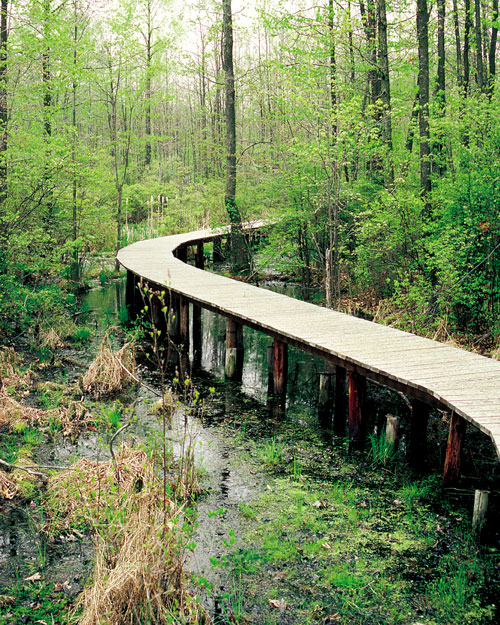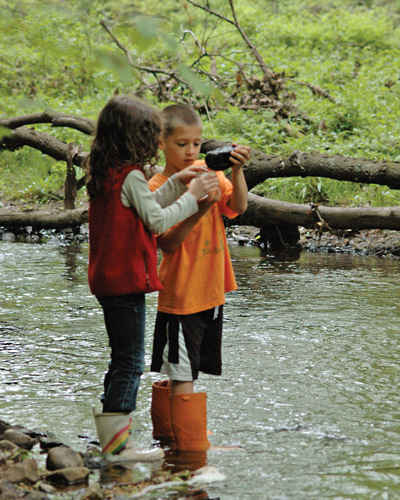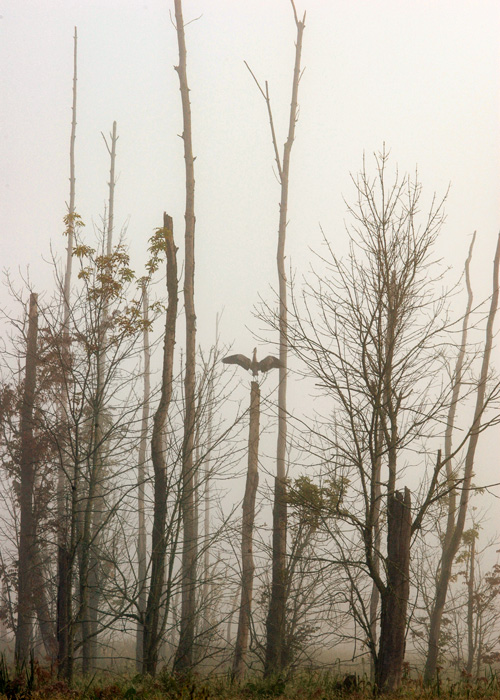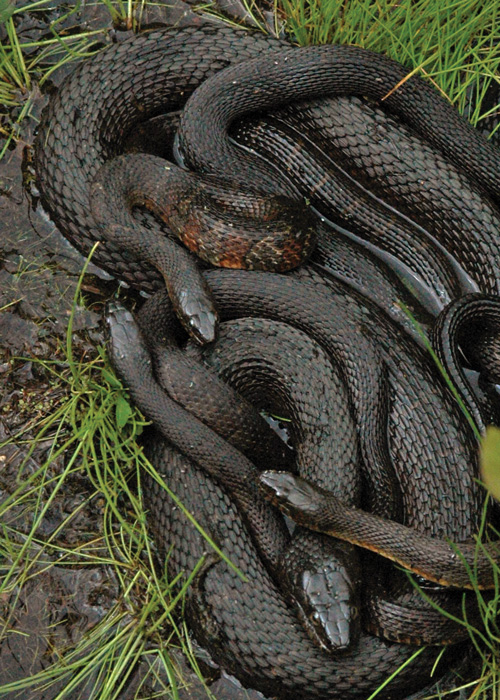
In 1959, galvanized community activists fought a proposed jetport that threatened the Great Swamp watershed. They raised enough money and support to donate thousands of acres to the U.S. Department of the Interior, and the Great Swamp National Wildlife Refuge was born. The Helen C. Fenske Visitor Center, named after one of the key community activists in the formation of the Wildlife Refuge, lies within reach of the Refuge Wilderness Area, where the public can explore the swampy outdoors.
Ryan, a tow-headed three year old, clutched my hand and balanced his small stocky body against the current. He had churned up the stream bed so that swirling mud hid his yellow sneakers. Muddy water stained the bottom of his shorts. Ryan squeezed my fingers and tried to lead us to the middle of the stream where his mother overturned rocks, looking for insects and the creepy crawly things that live in the stream bed.
"Wait just a moment, Ryan. Mommy will be right there." Ryan's mother, a volunteer in a Bio Blitz t-shirt, scraped some wormlike things off a rock and into a plastic bucket.

Older children dipped nets into the water. They carried fists full of muddy leaves to adults who waited with buckets and plastic containers. One small girl held up a clear plastic jar to stare at a tiny fish. Dr. Royal Nadeau, President of Eco Strategies Group, and our team leader, checked the buckets and tubs filled with stream water and assorted swarming creatures. He looked at his watch. "It's time to get these things back for a closer look," he said.
A similar sense of haste had cropped up during the morning's bird census. The naturalist leading our group had tried to hurry everyone down a dirt road that cut through the Great Swamp National Wildlife Refuge. When the long scopes came out he sighed. "We don't want to stay too long in one spot," he called. "We're supposed to find different birds." The naturalist hustled us through the restricted areas, checking eighty-one species off his bird list. When we returned to the main road he gave up and kept moving, leaving the stragglers behind.
Royal collected boxes and nets. A head count came up short. We found the two missing teenagers on the other side of the channel, in a little pool where a beaver had begun a dam. We carted kids, nets, and critters back to the new visitors' center and drove down Pleasant Plains Road to a yard covered with tents and display tables.
The command center for the Bio Blitz had developed the look and feel of a science fair. The event was designed to present a sampling of the variety of flora and fauna that could be found in a twenty-four hour period. Assorted teams explored the swamp from Friday evening to Saturday afternoon. Experienced participants sought the birds, bats, fish, bugs, crustaceans, mollusks that few people noticed. Some critters came back with the teams and crouched and slithered in jars and terrariums. Most of the naturalists and volunteers had a blasé approach to their collections. I passed one woman hunched over a bowl of small dark bugs. She ate a sandwich with one hand and sorted the bugs with the other, leaving startled spectators with the impression that she was adding live protein to her meal.
At the stream survey table, Royal identified the tiny creatures from the stream bed. I peered through a microscope at his side. A tiny wormlike thing wiggled on the glass. Magnified it developed monstrous proportions, sprouting legs and odd bumps and protrusions. It bent in on itself, straightened, and knotted into a pretzel. Someone added a few drops of alcohol on the glass. The critter straightened, trembled, and exhaled a soft brownish cloud of liquid. With an odd twinge of remorse, I realized I'd witnessed the last moments of a Trichoptera, a Nettube caddisfly.
Other captured animals, such as the black, garter, and milk snakes in a small terrarium, would later go free. Most of the recorded species appeared only as list items on a bulletin board. By mid-morning on Saturday the species count had reached 330. Volunteers noted the highlights: box and spotted turtles; an otter; an orchard oriole; a chain pickerel; slime molds; luna moths; a rosy maple moth; barred, screech, and great horned owls; brown trout. It was unclear if anyone had counted the mosquitoes making their home in my hair.
The northeastern section of the refuge, between New Vernon and Green Village, offers a tonic for stress and crowding. Woodland Road, which leads to a trail head in the swamp's wilderness area, cuts through a large farm whose fence and gate seem to deter visitors. Perhaps they think the drive is private; even on balmy summer days the parking lot at the end of Woodland is often empty. On these trails one is more likely to see tracks of otter and raccoon than those of people. The blue trail leads south, then north, passing overgrown meadows, bogs, and flowing streams. It is a place of many rewards for birders and naturalists, but the Bio Blitz had created a desire for companionship, for fellow swamp enthusiasts.

I drove down Long Hill Road, past several ponds where herons often feed, and pulled in to the Wildlife Observation Center. Volunteers often staff a small cabin on one side of the parking lot during the summer. They pass out brochures and share news of wildlife sightings. When I visited, a retiree in his late sixties sat in the open cabin. He seemed pleased to have company, and chatted while I studied the updated list of species seen at the Observation Center: orioles, wood ducks, herons, fox, turtles.
"A fox?"
"In the springtime. Had its young right here. They lived under the cabin."
As pleased as if the fox had been sighted that morning, he pointed to a row of photographs tacked to the door. A magnificent fox stared into the camera.
"Do you know what that is?"
He gestured in the direction of an enormous, solitary bee. The bee spiraled towards the parking lot and a photographer, muscle-bound and laden with cameras. The photographer walked towards the cabin.
"I believe that's a Homo sapien," I said.
The photographer pumped his arms and grunted. "Neanderthalis."
"No. I meant the bee," the retiree laughed. "That's a carpenter bee."
The bee did not interest the photographer, who wanted to show his morning's prize. He opened the camera's digital display to an image of eggs nestled in a clump of grass.
"Where did you take that?"
"Off the boardwalk. By the Sportsman Blind."
In the springtime mallards sometimes nest in the raised grass tussocks by the walk. Snapping turtles cannot reach the nests, but other nuisances can. The hens find themselves brooding their clutch directly under a barrage of cameras. The process is undeniably photographic: nest, hatchlings among the grass, wild irises, and lily pads of the marsh.
"It's a wood duck nest," he said.
"More likely a mallard. Wood ducks are cavity nesters. They like trees."
A lengthy debate ensued. The eggs were too large, too pale, and too ovaline; the nest, furthermore, was too exposed for a flighty wood duck hen. The eggs were too small to come from a Canada goose. The retiree tried to help and passed us a bird guide. It did no good; the photographer left unconvinced.
I walked out on the elevated boardwalk towards the Sportsman Blind. It was a noisy, warm afternoon. Large bullfrogs, yellow throat sacs stretching like taut balloons, grunted from the water. A couple, walking quietly, stared down at the turtles, frogs and flowering plants of the marsh. A boy followed them and stopped to point out a painted turtle swimming just below the surface of the water.
"Did you see the abandoned nest?" I asked.
"Mallard, isn't it?" The woman answered, her voice mellow and calm and very British.
"I believe so. Some might argue."
"Ah. The gentleman photographer. Homo sapiens adamans. Often found among beginning birders."
"Adamans?"
"Stubborn."
Her husband laughed.
"I tried to tell him it was a mallard," the boy said.

We strolled to the blind. Cuts in the wood provide a view of a large marsh, where egrets, bitterns and herons often hunt in the shallows. A doe and her fawn moved slowly through the grass. The fawn, its bright copper coat dotted with white, sparkled in the sunlight. The British couple borrowed my binoculars and scouted for birds in the trees. The boy ambled back onto the boardwalk and let out a shout. He pointed towards the base of a tree where a black snake working its hinged jaws around a frog.
"Oh, marvelous," the man said. "Although perhaps not for the frog."
"That's so cool," the boy breathed.
"I've never seen that before." The woman nodded towards the boy. "Our grandson is a positive genius at finding things. We call him our juvenile Homo sapien ferus."
"Ferus. Feral. Wild, really," the man explained. "When his mother needs a break we bring him here."
"When we need a break we bring him here," the woman added. She paused to listen to a woodpecker tapping at a tree. "This place is quite good for the soul."
The Great Swamp National Wildlife Refuge has two wildlife observation blinds and approximately eight miles of marked trails. Be careful not to stray onto deer paths; even regular visitors have been known to lose their way. You'll find a map here or when you visit the refuge.
Friends
of the Great Swamp
Fish and
Wildlife Service
Great Swamp Watershed Association
The Jacobus Vanderveer house is the only surviving building associated with the Pluckemin encampment.
Part of the Morristown National Historic Park, the formal walled garden, 200-foot wisteria-covered pergola, mountain laurel allee and North American perennials garden was designed by local landscape architect Clarence Fowler.
Even today, if you needed a natural hideout—a really good one—Jonathan’s Woods could work.
The Millstone Scenic Byway includes eight historic districts along the D&R Canal, an oasis of preserved land, outdoor recreation areas in southern Somerset County
Paths of green, fields of gold!